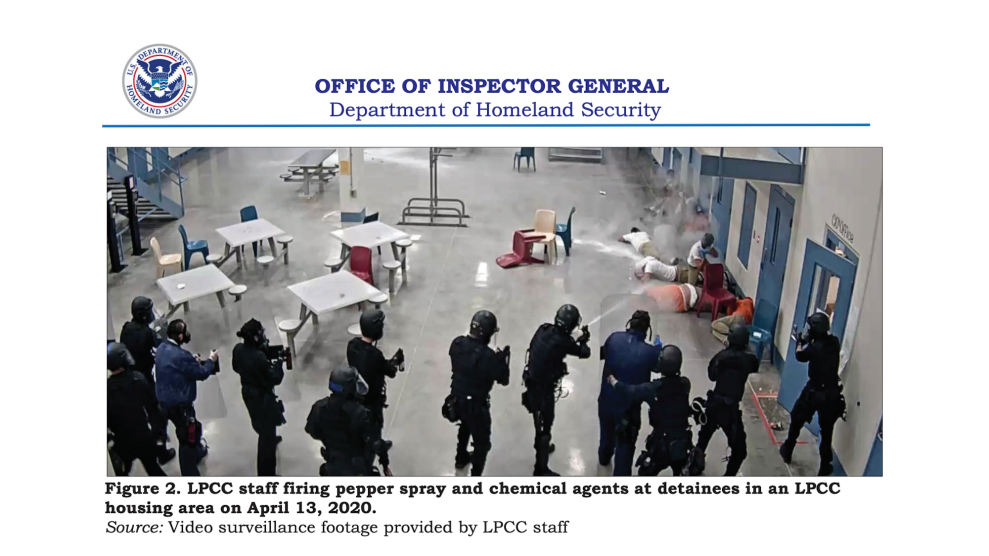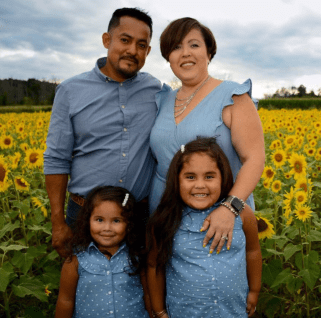
A still from surveillance footage included in a Department of Homeland Security Office of Inspector General report from March about pandemic-era violations of detention standards at the La Palma immigration detention center in Arizona. The people being pepper sprayed had been peacefully protesting to demand better protection from COVID-19./DHS OIG
In March 2020, the ACLU of Southern California sued the Department of Homeland Security to get people vulnerable to COVID-19 out of Adelanto, an immigration detention center east of Los Angeles. Among them was Martin Vargas Arellano, a 54-year-old Mexican citizen who suffered from diabetes, high blood pressure, and hepatitis C. A federal judge quickly ordered Vargas released, but put the order on hold when a plan for Vargas to go move to a Los Angeles community center fell through. In December, Vargas, still detained, tested positive for COVID-19 before becoming severely ill.
On March 15, the ACLU learned via a weekly update in a different lawsuit that Vargas had been released 10 days earlier. ICE hadn’t told Margaret Hellerstein, Vargas’ attorney at the LA-based Esperanza Immigrant Rights Project, who had no idea where her client was. On March 16, she filed a missing persons report, the San Bernardino Sun reported. A law enforcement official investigating her report told Hellerstein that Vargas’ last known address was a Southern California hospital. She soon learned that Vargas had been dead for more than a week. He’d had a stroke on March 3, been released by ICE two days later, then died three days after that.
By releasing Vargas just before he died, ICE skirted its legal obligation to report when someone dies in its custody. To this day, ICE’s webpage states lists no deaths among the 270 detainees it says have tested positive at Adelanto. Stories like Vargas’ are at the center of a new ACLU report on the cost COVID-19 has had on people in immigration detention. Since the start of the pandemic, the organization has filed more than 40 lawsuits that have led to the release of more than 800 people from detention.
According to ICE’s own statistics, 14,057 people have tested positive for COVID-19 while in the agency’s custody. As of Sunday, a staggering 1,906 of the roughly 16,700 people in detention right now are being monitored for active COVID-19 infections. If the United States had a similar infection rate, there’d be nearly 40 million active infections at the moment, as opposed to the roughly 560,000 that have been recorded over the past two weeks. Eunice Cho, a senior staff attorney at the ACLU, notes that the number of people ICE is detaining has been rising in recent weeks, although it remains far below the record of more than 55,000 people reached during the Trump administration.
Officially, nine people in ICE custody have died from complications from COVID-19. But that doesn’t include people like Vargas or Óscar López Acosta, who died shortly after being released from the Morrow County County Jail in Ohio last year.
Although the United States has so many extra vaccine doses that New York City is now vaccinating international tourists in Times Square, ICE has not announced a comprehensive plan for vaccinating the people in its custody. “It simply boggles the mind,” Cho says about the failure to do so. The result is rapid transmission of the virus inside detention centers at a time when cases are falling across the country.
The ACLU report calls on ICE to make a number of changes to protect people from the pandemic. Foremost among them is closing detention centers that were opened in recent years, as well as those with records of abuse. Instead of detention, the ACLU wants ICE to use alternatives like community-based case management programs.
Another set of recommendations focuses on transparency. ICE, for example, refuses to say how many people in its custody have been hospitalized with COVID-19. “Without that information, we’re never going to get a sense of the actual scale of very serious suffering that happened as a result of COVID-19 and ICE detention,” Cho explains.
The agency also doesn’t proactively report when it uses force against people in detention who protest their treatment. When it does confirm such uses of force to reporters, it uses sanitized language—staff used pepper spray and “detainees became complaint” is a common construction—that obscures the horror of what people actually endured. The ACLU is asking ICE to start reporting those uses of force, as well as other events like hunger strikes.
The bulk of the new report is devoted to letting people who experienced the pandemic from detention share what they endured. One of them is Oscar Xirum Sanchez, a 42-year-old husband and father of two young girls, ages 3 and 6. Xirum tested positive for COVID-19 in October during an outbreak at Michigan’s Calhoun County Correctional Facility. He was sick for a month and ran a fever as high as 106 degrees. He remembers being told by a nurse, “You think you have a fever, but you do not. You are not sick.”

Oscar Xirum Sanchez with his wife and daughters.
ACLU
For the first 20 days he was sick, he lived among fellow detainees. Then, during an 11-day quarantine, he was not allowed to shower. (In the early days of the pandemic, I spoke to many people in detention who hid COVID-19 symptoms because it would have meant being sent to solitary confinement.) Xirum was eventually released as a result of an ACLU lawsuit. He still has trouble breathing. The report states that his 6-year-old cries whenever he leaves home because she’s afraid he won’t come back.
Aaron Hope, who came to the United States from Trinidad and Tobago when he was nine years old, is representative of what happened to those who demanded protection from the virus. Like many people in detention, he learned about how quickly COVID-19 was spreading while watching TV news in a crowded unit—60 people in his case—in which it was impossible to practice social distancing. He went on a hunger strike to demand hand sanitizer, soap, and other cleaning supplies. In response, guards put him in solitary confinement for two weeks.

Aaron Hope
ACLU
“When they took me to [solitary], an officer said, ‘I remember you, you were giving us a hard time about COVID. I knew you would be in here soon,’” Hope recalls in the report. “And I thought: I was giving you a hard time? Because I care about my rights and my life?”
Adebodun Idowu, a 57-year-old Nigerian man with diabetes and high blood pressure, became infected with COVID-19 while detained at the Clinton County Correctional Facility in Pennsylvania. The clinic at the facility told him to drink water then sent him back to his unit. From there, he was put in isolation.
After five days alone, ICE released him to live with his family. His health continued to get worse and, after an ambulance took him to a hospital, a doctor confirmed he had COVID-19. He remained hospitalized for a month. At times, his doctors thought he might die. If he hadn’t survived, his death would have never appeared in ICE’s statistics.
















